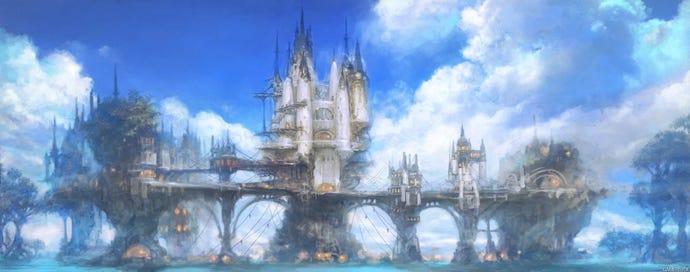Final Fantasy XIV Review
Against all odds, Square Enix's second attempt at a Final Fantasy MMO is back for another shot at glory. Does it have what it takes to survive in a market that has changed significantly in the last few years, or should Yoshi-P have left Eorzea crushed beneath Bahamut's wrath?
This article first appeared on USgamer, a partner publication of VG247. Some content, such as this article, has been migrated to VG247 for posterity after USgamer's closure - but it has not been edited or further vetted by the VG247 team.
Primary Reviewer, Pete Davison
Not many MMOs get a second chance after a disastrous failure, and it's abundantly clear from the moment you fire up A Realm Reborn that Square Enix fully intends to make up for the mistakes of the past.
At the same time, though, despite its numerous shortcomings, version 1.0 of Final Fantasy XIV had its fans and active players. Rather than attempting to forget the whole situation ever happened and rebooting the game from scratch, Naoki Yoshida and his team have instead acknowledged the things that people liked about version 1.0 and woven them into both the structure and narrative of A Realm Reborn, in the process creating a game that is both accessible to newcomers and full of pleasing callbacks for those who endured the original's foibles.
Like Square Enix's previous massively multiplayer adaptation of the series Final Fantasy XI, A Realm Reborn is in an interesting and challenging position. It's attempting to cater to two distinct markets: MMO players and Final Fantasy fans. While there's a certain degree of overlap between the two -- both groups enjoy games with swords and potions and numbers that get bigger the longer you've been playing -- they are two very different types of experience.
Can A Realm Reborn successfully cater to both? Let's find out.
To the MMO Fans
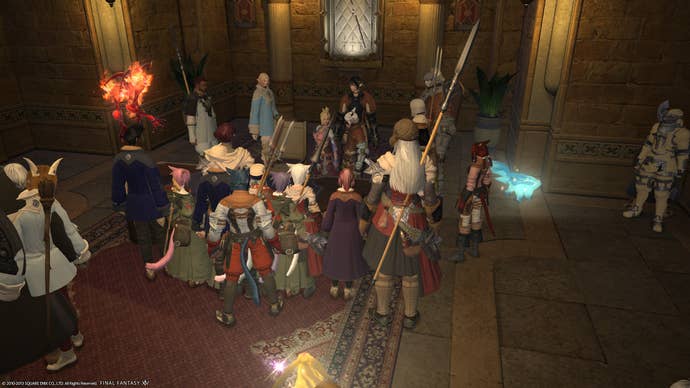
As an MMO, A Realm Reborn initially doesn't appear to stray especially far from the conventions popularized by World of Warcraft. You play an individual character, you can acquire experience points through completing quests acquired from NPCs and battling monsters, and there's a "rest bonus" mechanic in place that gives additional experience points to those who have been away from the game for a while -- and who remembered to log out in a Sanctuary location. Later in the game, you'll be running dungeons with other players, and the public chat channels inevitably have at least one dribbling buffoon or gold spammer who quickly gets blacklisted by everyone else in the area. Business as usual.
Each class plays delightfully distinct from the others, even within the same character archetype.
As you progress through the levels, more and more possibilities start to present themselves, and the game starts to distinguish itself more obviously from its rivals. The guild that represents your starting class begins offering you unique quests that other types of characters can't take on; you unlock a Hunting Log, which provides enormous experience point rewards for tracking down specific creatures in the world; you gain access to the Guildhest and Levequest systems, which provide short, snappy, repeatable challenges to co-op groups and individuals respectively; and most importantly, you unlock the Armory system, which allows you, at any point, to throw up your hands, say "balls!" to your current occupation and switch to a completely different character class -- including a non-combat-focused one if you so desire. Later on, you can even combine skills from different classes to make your own distinctive build.
I was concerned upon first starting up the game that it would be yet another hotbar-and-cooldown-based MMO with predictable combat, but I was pleased to discover that each class plays delightfully distinct from the others, even within the same character archetype. For example, just within the damage dealer/DPS category, Thaumaturgists focus on standing well back from combat and flinging devastating spells that take a few seconds to cast; Archers, meanwhile, are able to freely move around while unleashing their various arrow-based skills, making them particularly good for kiting enemies and avoiding special attacks. Pugilists, meanwhile, are a melee-based DPS class that do their best damage when sneaking up behind an enemy.
And besides simple differentiations like skill speeds, each class has its own interesting, unique mechanics, too. Pugilists, for example, make use of a combo system whereby certain moves naturally lead into others; Thaumaturgists, meanwhile, can affect both their damage output and MP regeneration rates according to which spells they cast. One particularly nice thing about A Realm Reborn's class-specific quests is that not only do they provide a thematically-appropriate narrative to follow for each type of character, but they also actually teach you how to play as that class effectively -- essential training for those who are new to MMOs, or who are trying out a new party role for the first time.

A Realm Reborn's community is, generally speaking, slightly older and/or more mature in its behavior than in many other rival titles.
Socially speaking, the game has an interesting, if fairly conventional array of options. A friend list function allows you to see when specific players are online, though doesn't offer the facility to add players from other servers, nor does it allow you to add players when they're offline. The Linkshell facility returns from Final Fantasy XI, but instead of replacing other MMOs' guild functionality like in the past game, here they're more like custom chat channels, and you can use up to eight of them at any one time rather than being limited to one. A Realm Reborn's guild equivalents are Free Companies, and these work as you might expect -- players can be ranked into different tiers and given different permissions; those with the appropriate permissions can post a message of the day that appears on login; high-ranking Company officers can bestow benefits such as experience point boosts on all members; there's communal storage and a global chat channel; and the Company can rank up over time -- though at present it doesn't take very long to reach this cap if you have an active or large group.
The game's community, on the whole, is very helpful -- articulate, polite and patient with newcomers for the most part. There's the occasional jackass, as there is in any online game, but rather than trolling behavior being laughed at and tacitly encouraged, most people make swift and unforgiving use of the Blacklist system. It's clear from talking to many players, both in the public chat channels and the linkshells and Free Companies I've had contact with, that A Realm Reborn's community is, generally speaking, slightly older and/or more mature in its behavior than in many other rival titles, which is encouraging to see and a pleasure to be a part of. Let's hope it continues.
A highlight of the experience is the Duty Finder system, which automatically forms parties from players from a selection of servers -- not just the one you created your character on -- for instanced group content such as dungeons, boss fight "trials" and the short, snappy Guildhests. Early game content tends to make use of a "light party" formed of just four people -- one tank, one healer, two DPS -- and this expands to an eight-person "full party" in later challenges. DPS characters vastly outnumber tanks and healers on most servers, which means queue times for dungeons are typically 30-45 minutes at a time for these classes; conversely, healers and tanks can usually find themselves a party almost instantly, though there is much more pressure on these classes to know how to play their role effectively in a group.
Despite the long wait times for DPS classes, though, the Duty Finder is a reliable means of getting a party together when you're still getting to know people or don't have a Free Company to rely on -- the only real disappointment I have about it is the inability to stay in touch with people once they've left the instance, since you're almost inevitably all from different servers. You can get around this by looking up a character on the Web-based Lodestone service and following them, however -- while this doesn't allow for in-game communication, it does at least let you stay up to date with a favorite player's progress and make contact with them.
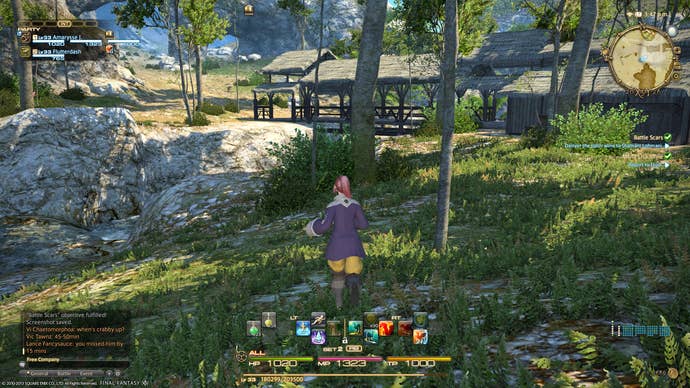
It's relatively rare to find a boss that requires nothing more than a simple "tank and spank" approach.
The dungeons themselves are interestingly designed, though sometimes a little light on contextual explanation of why you need to complete particular objectives. The real attraction of them, though, is the bosses -- even in the early-game dungeons, it's relatively rare to find a boss that requires nothing more than a simple "tank and spank" approach. Some bosses have puzzle elements; others require the tank to lead enemies around carefully as well as protecting the party; others still require a keen awareness of the whole battlefield to deal with additional incoming enemies or environmental elements. The game is pretty good at providing tips for these fights, too, meaning even the most stubborn Leeroy Jenkins types shouldn't get too stuck or frustrated.
If you're one for a more unstructured cooperative experience, you can earn a decent amount of experience and other rewards from the game's Full Active Time Event (FATE) system. These are similar to the public quests seen in titles such as Guild Wars 2, and come in a number of different forms -- collectively dogpiling on a super-tough boss monster; protecting characters from harm; dealing with an overwhelming swarm of enemies; or escorting a character from one place to another. FATEs are initially completely bewildering, but making good use of the game's excellent target-filtering system and learning to concentrate on the helpful on-screen information rather than the distracting pyrotechnics all around you will eventually see you become a skilful wandering adventurer. It's been interesting to see a dedicated "subculture" spring up around these -- groups of players who party up specifically for the purpose of moving from FATE to FATE and maximizing their rewards.
Fans of non-combat occupations are well catered to with the Disciples of the Hand and Disciples of the Land character classes -- the former are crafting classes, while the latter are gathering occupations. Each of these, like the combat-centric classes, has its own individual experience level, allowing you to level them up independently of one another without having to make compromises. They even have their own unique story-based questlines to follow as well as repeatable Levequests, allowing you to make a comfortable virtual living from your profession of choice -- alternatively, you can just work your way through your Crafting Log until you've made everything. The choice, as is the pattern for much of the rest of the game, is yours, though you'll want to keep an eye on your spending when acquiring raw materials -- money can easily get tight in the late game.
Crafting and gathering aren't passive processes, either -- as you level up each class, you'll learn new skills that enable you to either craft better quality items (which nets you more experience per item made) or find higher quality ingredients. Crafting is depicted as a turn-based battle between you and the materials; you'll have to carefully make use of your skills in order to complete the item before its durability runs out. Making items is often a multi-step process, too -- for example, to make a pair of pants you might have to spin some cotton bolls into cotton yarn, then weave the yarn into cloth, then combine it with leather and rivets to finish the job. Thankfully, a Quick Synthesis option allows you to make batches of items if you already have the ingredients on hand, making more complicated assignments more straightforward than they could have been.
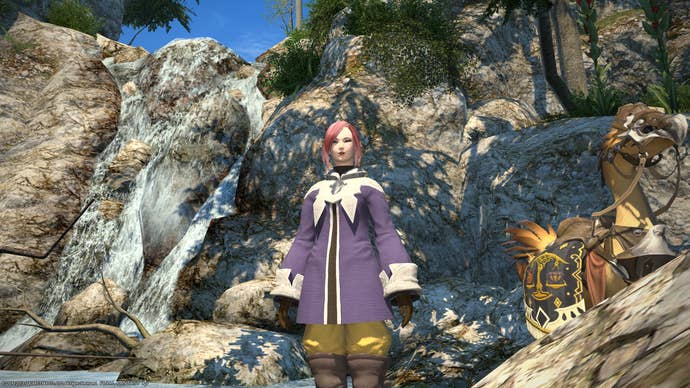
Those who want to play the market with their loot or crafted items can do so with a solid Market Board system, which works in conjunction with the game's charming Retainer mechanic. Essentially, this allows you to custom-design your own personal servants using the same character creation tools given to players, summon them and then ask them to either look after your gear or go and sell it on the marketplace. A simple to understand interface allows you to track the market history on a particular item and set an appropriate price, and if you're a buyer, some straightforward search tools make it easy to find what you're looking for. Variable tax rates between the game's three city-states encourage you to branch out and try hawking your wares in different locations, too.
On the whole, then, A Realm Reborn offers a solid, complete MMO experience that, while not exactly revolutionary in many ways, is extremely addictive, satisfying and enjoyable to play -- and certainly a lot less clunky, unintuitive and discouragingly difficult as Final Fantasy XI was. So long as Yoshida and the team make good on their promises to 1) ensure there's plenty of meaningful, challenging end-game content and 2) keep new content coming every three months, they'll have a strong contender on their hands -- likely not enough to topple genre giants like World of Warcraft, but a game set to enjoy a strong, dedicated, passionate community for many years to come.
To the Final Fantasy Fans
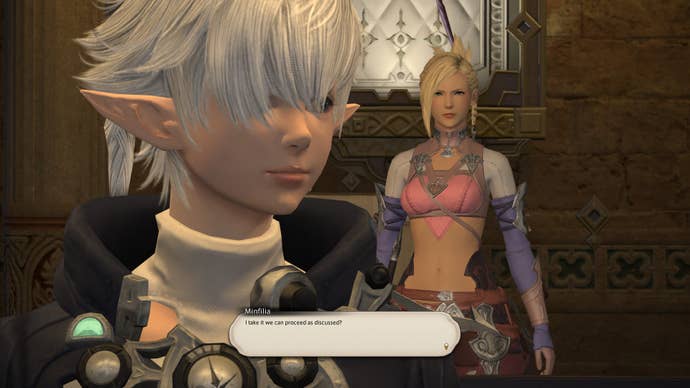
It's a bit of a shame your character is relegated to the role of silent protagonist... but the story you're following is enjoyable.
What does A Realm Reborn offer to long-serving Final Fantasy veterans? One word: fanservice. And not of the "otaku games" variety; this is Final Fantasy series fanservice we're talking about here. The game is riddled with it, whether it's the Magitek armor that primary antagonists the Garlean Empire are using; the fact that there are characters called Biggs and Wedge who fly an airship called the Tiny Bronco; or that all the example phrases used in the chat filter menu are quotes from FFVII's Cloud Strife. Structurally, the game has most in common with Final Fantasy XII's open world, but the aesthetic also calls to mind Final Fantasy VI. Someone on the team obviously likes Final Fantasy II, too, because there's a lot of "wild rose" references, and some quests even replace the usual combat music with a fantastic remix of Final Fantasy II's battle theme.
The game's story is set five years after Final Fantasy XIV's first version. This allows it to tell a brand new tale while simultaneously allowing for callbacks to past events for legacy players -- a good solution to a tricky situation. I never played the original Final Fantasy XIV and certainly don't feel I've been missing out on any story context -- it's simply like any other RPG where something dramatic happened prior to the events depicted in the game; the only difference here is that some players "lived" through those events, which is pretty cool.
I was a little concerned that the game's MMO sensibilities would push the "Final Fantasyness" aside, though -- this is, after all, something that Final Fantasy XI suffered from to a certain degree at times, particularly when progressing through the game became more dependent on level grinding with parties than advancing through the story. That's not to say Final Fantasy XI didn't have its cool moments -- that first boss fight against the dragon was pretty great -- but at times its "MMO-ness" overwhelmed the elements that might appeal to the crowd who have played every other Final Fantasy game.
Thankfully, A Realm Reborn addresses this extremely well by putting the ongoing storyline front and center. The game's "main quest," which you'll find yourself dipping in and out of as you naturally work your way around the diverse locations in the game world, is an interesting tale with some colorful characters, wonderfully loathsome villains and a real sense that your character is important to the ongoing plot, helped along by subtle use of phasing to slightly tweak locations and NPCs according to your progress through the narrative. It's a bit of a shame that your character is relegated to the role of silent protagonist rather than actually having any lines and it's equally disappointing that voice acting in the game is kept to a minimum, but these are relatively minor criticisms when the actual story you're following is so enjoyable -- and when the instanced battles and setpieces you get involved with without the interruption of other players are so much fun to be a part of. (Also, while the quality of the voice acting is a little inconsistent, it's nice to hear some British accents in the cast.)

A Realm Reborn feels very much like a true entry in the Final Fantasy series.
The main quest has a convenient second purpose, too -- it leads you on a grand tour of the game world, encouraging you to seek out sidequests, gain experience and learn about the game's various mechanics. It introduces you to running dungeons and taking on the enormous, spectacular "Primal" bosses with other players; it brings you to a point where you can finally get a chocobo to ride; it teaches you how to get between the game's three major cities in various different ways. It's an extremely simple but hugely effective piece of game design that, in itself, helps A Realm Reborn feel very much like a true entry in the Final Fantasy series.
The feeling that this is a well-crafted world that has had love, care and attention poured into it persists outside of the main quest, too; every place you visit has NPCs you can make small talk with, and some excellent use of sound makes the world feel truly "lived in." Walk into an inn that has lots of players present, and the game adds ambient crowd noise, with the volume dependent on how many people are there; join a busy FATE battle and you'll hear your compatriots roaring and cheering as you go about your violent business. The atmospheric sound is complemented by some wonderful music that beautifully captures the varied characters of the game's diverse land and cityscapes, and when it's time to draw your sword, the game's battle themes are all stirring, dramatic and memorable. Plus, of course, the iconic Final Fantasy fanfare is present, correct and used liberally -- a short sting when you level up; the full version when you beat a dungeon or other co-op challenge.
In short, if you were worried that the game's massively multiplayer nature would make it feel more like World of Warcraft than a mainline Final Fantasy title, you don't have much to worry about. Yes, you'll have to adjust to the considerations of playing with other people -- controlling only one character rather than a party; waiting in queues to complete dungeons and boss fights rather than charging in the second you're ready; learning to mute the braying idiot bellowing about genitalia in the Ul'Dahn marketplace -- but the game does a great job of making itself as accessible and understandable as possible, and in doing so manages to combine the best of two worlds.
In short, if you're sick of Lightning, this is the Final Fantasy you should be playing.
Second Opinion, Mike Williams
As an avid MMO player, I went into Final Fantasy XIV: A Realm Reborn with what could charitably called curiosity. I had played the original incarnation of the game, which was a dire implementation of a Final Fantasy MMO. The less is said about that game, the better. It's rare for an MMO to get a second chance these days without switching business models, but Square Enix was ballsy enough to change the guard, raze the game to the ground, and build a new title within its carcass.
What more surprising is that it actually worked. Final Fantasy XIV is a great MMO. It will probably go into my MMO rotation from now on. I can't say I'll be subscribed to it for every month in a year, but starting up the sub when the desire strikes me is quite doable.
Part of the game's appeal is how much it doesn't change; Final Fantasy XIV doesn't reinvent the wheel. A larger part of the gameplay can but found in other titles: FATEs are public quests, enemies visually telegraph their special moves, the Market Board is an auction house, and the duty finder is like another famous MMO's instance finder. But FFXIV doesn't need to reinvent the wheel because these are all proven ideas that work; there's no reason to go and implement your own ideas that won't work just to be innovative.
The Final Fantasy brand and aesthetics will drive you to do things you probably wouldn't do in another MMO.
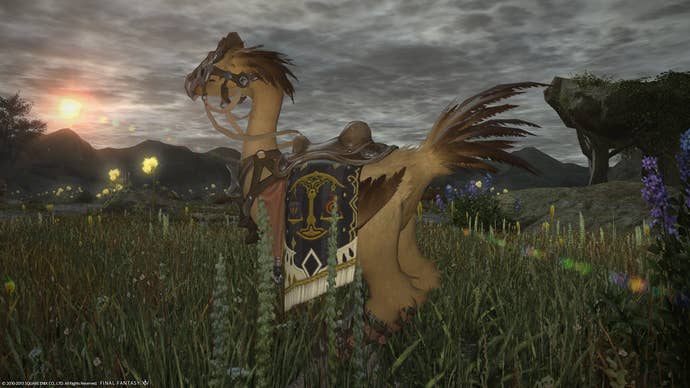
That's not to say Final Fantasy XIV doesn't have its own spin on things. The Job system is a big draw for me -- Final Fantasy Tactics and Final Fantasy V are two of my favorites in the series -- and it changes how the game is played significantly. I've found that myself and others are more likely to stick with a single character in FFXIV, instead of creating numerous alts. Since you can easily switch to a new class by equipping new gear without any penalty, it frees players up to experiment outside of their comfort zone. It greases the rails for exploration of the game's wide variety of classes, instead of locking you into your beginning choices like most MMOs do.
There's also a lot to be said for the "Final Fantasy" part here. The brand and the aesthetics behind it will drive you to do things you probably wouldn't do in another MMO. If you're an FF fan, you'll want your Chocobo or Magitek mount. The Carbuncle pet may convince you to try out the Arcanist class. You'll finish dungeons on your high-level Dragoon so you can look like Final Fantasy IV's Kain Highwind. You might hunt down specific encounters in order to get the Baby bomb or Baby Behemoth pets. The game and team are Square Enix are cognizant of the power and history behind Final Fantasy, and from what I've seen they're using it to draw players deeper into the game.
Final Fantasy XIV: A Realm Reborn stands as a testament to second chances. Game director and producer Naoki Yoshida did not waste that chance and proved there was still life left in the game. I still think the subscription fee may prove a barrier for players, but if they get beyond that, they'll find an MMO worth playing.
The Nitty Gritty
- Visuals: The game looks authentically Final Fantasy, with some distinctive character designs and sprawling landscapes. It's pretty scalable, too; you can run it on a wide variety of systems without sacrificing too much detail, and the game rarely chugs even when the screen is full of enemies, players and pyrotechnics in a busy FATE.
- Music: From the stirring, triumphant orchestral pieces that accompany the three main city states to the various pulse-pounding battle themes, Final Fantasy XIV has an incredibly strong soundtrack -- not just "good for an MMO" but "good," period.
- Interface: A real highlight of the game is that it works just as well played from your couch with a controller as it does at your desk with mouse and keyboard.
- Lasting Appeal: There's already a wealth of content available in the game, and with regular updates promised every three months, this should have a good, long tail.
ConclusionSquare Enix has pulled off the seemingly impossible: rescuing a disastrous flop of an online game without going free-to-play, and creating an incredibly addictive, satisfying experience for both MMO and Final Fantasy veterans in the process. A Realm Reborn is a triumph for Naoki Yoshida and his team.
